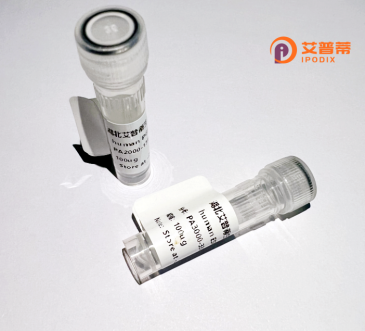
| 纯度 | >90%SDS-PAGE. |
| 种属 | Human |
| 靶点 | NSD1 |
| Uniprot No | Q96IT1 |
| 内毒素 | < 0.01EU/μg |
| 表达宿主 | E.coli |
| 表达区间 | 1-587 aa |
| 活性数据 | MPTALCPRVL APKESEEPRK MRSPPGENPS PQGELPSPES SRRLFRRFRY QEAAGPREAL QRLWDLCGGW LRPERHTKEQ ILELLVLEQF LAILPREIQS WVRAQEPESG EQAVAAVEAL EREPGRPWQW LKHCEDPVVI DDGDSPLDQE QEQLPVEPHS DLAKNQDAQP ITLAQCLGLP SRPPSQLSGD PVLQDAFLLQ EENVRDTQQV TTLQLPPSRV SPFKDMILCF SEEDWSLLDP AQTGFYGEFI IGEDYGVSMP PNDLAAQPDL SQGEENEPRV PELQDLQGKE VPQVSYLDSP SLQPFQVEER RKREELQVPE FQACPQTVVP QNTYPAGGNP RSLENSLDEE VTIEIVLSSS GDEDSQHGPY CTEELGSPTE KQRSLPASHR SSTEAGGEVQ TSKKSYVCPN CGKIFRWRVN FIRHLRSRRE QEKPHECSVC GELFSDSEDL DGHLESHEAQ KPYRCGACGK SFRLNSHLLS HRRIHLQPDR LQPVEKREQA ASEDADKGPK EPLENGKAKL SFQCCECGKA FQRHDHLARH RSHFHLKDKA RPFQCRYCVK SFTQNYDLLR HERLHMKRRS KQALNSY |
| 分子量 | 66.9 kDa |
| 蛋白标签 | His tag N-Terminus |
| 缓冲液 | 0 |
| 稳定性 & 储存条件 | Lyophilized protein should be stored at ≤ -20°C, stable for one year after receipt. Reconstituted protein solution can be stored at 2-8°C for 2-7 days. Aliquots of reconstituted samples are stable at ≤ -20°C for 3 months. |
| 复溶 | Always centrifuge tubes before opening.Do not mix by vortex or pipetting. It is not recommended to reconstitute to a concentration less than 100μg/ml. Dissolve the lyophilized protein in distilled water. Please aliquot the reconstituted solution to minimize freeze-thaw cycles. |
以下是3篇与重组人NSD1蛋白相关的参考文献及其核心内容概括:
### 1. **"Structural basis for histone H3 lysine 36 methylation by NSD1"**
- *作者*:Han et al. (2020)
- *摘要*:该研究解析了重组人NSD1蛋白与其辅因子S-腺苷甲硫氨酸(SAM)及核小体底物的复合物晶体结构。首次揭示了NSD1通过特定结构域识别组蛋白H3的N端尾部,并通过变构机制催化H3K36的二甲基化,为Sotos综合征相关突变提供了分子解释。
### 2. **"NSD1 regulates ribosomal RNA synthesis through H3K36 methylation"**
- *作者*:Branzei et al. (2019)
- *摘要*:通过体外重构实验发现,重组NSD1蛋白通过甲基化核糖体DNA(rDNA)区域的H3K36.促进RNA聚合酶I介导的rRNA转录。研究揭示了NSD1在核仁功能调控中的新作用,并发现其缺失导致细胞增殖异常。
### 3. **"Recombinant NSD1 characterization reveals dysregulated chromatin interactions in Sotos syndrome"**
- *作者*:Martinez-Garcia et al. (2017)
- *摘要*:利用重组NSD1蛋白进行染色质结合实验,发现Sotos综合征患者的NSD1突变体(如p.E1099K)丧失与染色质修饰复合物MBD1的互作能力,导致全基因组H3K36me2模式紊乱,解释了患者中神经发育异常的分子机制。
---
如需要更多文献细节或扩展研究领域,可进一步补充说明。
Nuclear receptor-binding SET domain-containing protein 1 (NSD1) is a histone methyltransferase critical for epigenetic regulation. It catalyzes the dimethylation and trimethylation of histone H3 lysine 36 (H3K36me2/me3), modifications associated with transcriptional activation and chromatin stability. NSD1 contains multiple functional domains, including a SET domain responsible for its catalytic activity, PHD fingers for chromatin interaction, and a PWWP domain facilitating DNA binding. This multidomain architecture enables NSD1 to integrate chromatin signaling and modulate gene expression programs.
Dysregulation of NSD1 is implicated in human diseases. Germline mutations or deletions cause Sotos syndrome, a congenital disorder characterized by overgrowth, developmental delays, and autism spectrum features. Conversely, somatic NSD1 alterations are linked to cancers, including acute myeloid leukemia, glioblastoma, and lung adenocarcinoma, where it can act as an oncogene or tumor suppressor depending on context. NSD1’s dual role highlights its tissue-specific regulatory functions.
Recombinant human NSD1 protein, typically produced in mammalian or insect expression systems, preserves post-translational modifications and enzymatic activity. It serves as a vital tool for studying histone modification mechanisms, screening epigenetic inhibitors, and elucidating NSD1’s interaction networks. Recent efforts to develop NSD1-targeted therapies, particularly for cancers with NSD1 translocations, further underscore its biomedical relevance. Ongoing research aims to unravel its context-dependent roles and exploit its therapeutic potential.
×